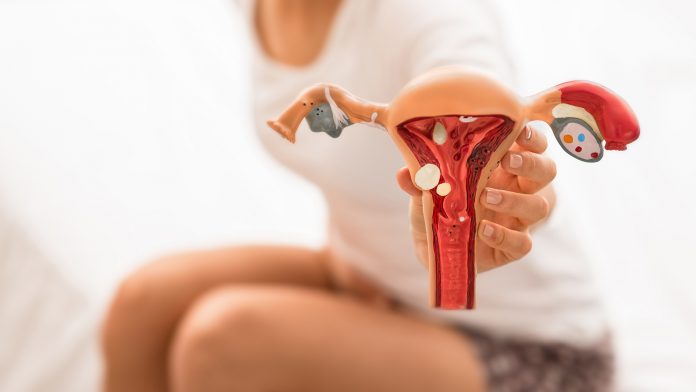
One in 10 women is affected by endometriosis yet the condition remains poorly understood and undertreated. Health Europa Quarterly spoke to Endometriosis UK about the challenges in access to care and how the organisation is working to raise awareness about the condition.
Though for many it may feel as though we are moving towards a post-pandemic era, the effects of COVID-19 continue to be heavily felt within healthcare where the backlog of vital healthcare services continues to grow. According to a report by the Royal College of Obstetricians & Gynaecologists, over 570,000 women in the UK are estimated to be on a waiting list for gynaecology, a 60% increase compared to pre-pandemic levels. Given that endometriosis can take years to be diagnosed and is the second most common gynaecological condition in the UK, this presents a particularly worrying situation for those affected.
Endometriosis is a condition whereby cells similar to those lining the womb build up in other parts of the body. While cells that accumulate in the womb leave the body during menstruation, similar cells located elsewhere build up, breakdown and bleed, but have no way to escape, which results in pain, inflammation and other symptoms such as fatigue and fertility issues. Even though millions of women around the world are suffering from the effects of endometriosis, research and treatment for the condition are woefully lacking. To discuss the key challenges in endometriosis care, Health Europa Quarterly spoke to Endometriosis UK, a charity dedicated to breaking the silence on endometriosis in order to improve the quality of life for the many women affected.
How important is early diagnosis in the treatment of endometriosis? Has the impact of the COVID-19 pandemic on healthcare services affected the rate at which endometriosis can be diagnosed and treated?
Shockingly, it currently takes on average eight years to get a diagnosis of endometriosis in the UK1 , a figure that has not changed in a decade. Delays to diagnosis mean delays in getting the right treatment as well as the distress of numerous GP, hospital, and even A&E appointments that do not identify a cause for the symptoms being experienced. An inquiry undertaken by the All Party Parliamentary Group (APPG) on Endometriosis in 20201 found that prior to diagnosis of those with endometriosis in the UK:
- 59% visited their GP more than 10 times with symptoms;
- 43% had more than five hospital appointments due to symptoms; and
- 53% went to A&E with symptoms, 27% went more than three times.
While some forms of endometriosis can be diagnosed through imaging, others with the condition require a diagnostic laparoscopy, a form of keyhole surgery.
The COVID-19 pandemic has led to increased waiting times for gynaecology appointments including diagnostic laparoscopy. A report recently released by the Royal College of Obstetricians and Gynaecologists (RCOG) on waiting times2 found that gynaecology was the service with the biggest percentage increase in waiting lists across the UK.

Can you outline some of the ways in which the condition can affect a person’s mental and physical wellbeing?
Endometriosis is a spectrum condition; some with the disease have little or no symptoms while others experience chronic and debilitating pain that negatively impacts both physical and mental wellbeing.
Common symptoms of endometriosis include chronic pelvic pain, painful periods, bladder and bowel associated pain and fatigue. The condition can also result in fertility problems. Those experiencing painful symptoms can find it affects their daily life, for example, needing to take sick leave, being unable to go to school, college or university, having to curtail social activities, and struggling with daily living tasks. This has a negative impact on educational achievement, career, relationships, family, and social life.
Endometriosis can have a negative impact on mental wellbeing, particularly when someone struggles to manage painful symptoms and if they spent many years having their pain and symptoms ignored or dismissed before being diagnosed.
How much is known about the causes and risk factors associated endometriosis? Are there any lifestyle measures that can be taken to lessen the impact of the condition?
Sadly, due to a historical lack of research into endometriosis, the cause of the condition is not yet known and there are no curative endometriosis treatments, only treatments to help manage symptoms. While there is a family history of endometriosis in some with the disease, no genetic links have yet been identified, although there is research underway in this area.
Unfortunately, the treatments currently available do not work for everyone, so some are left struggling to manage, which has a negative impact on both physical and mental health.
In relation to lifestyle, there is a lack of evidence around measures that might help those with endometriosis. For example, many claims are made in relation to nutrition including supplements, but there is not sufficient research to back them up. However, some with endometriosis have found that changing their diet, for example cutting out or reducing the amount of red meat, wheat and dairy products has had a positive effect.
We hear from the endometriosis community that many find gentle physical activity like walking and yoga to be beneficial. There is a lack of good quality research in this area, although there are some studies indicating that physical activity may help manage pain and reduce stress in those with endometriosis.3 In addition, physical activity is known to be good for general physical and mental wellbeing for everyone.
What key steps would you like to see taken to promote a better quality of life for people living with the condition? What could be done at a policy level to improve diagnosis, treatments and also encourage greater research in this area?
The key policy changes that we campaign for are:
- Fully implementing the relevant NICE guidance on endometriosis to ensure a baseline of care for all with endometriosis including access to specialist care where needed;
- Reducing diagnosis times to an average of under four years by 2025 and under one year by 2030 – this will require investment in diagnostic capacity, streamlining diagnostic pathways and healthcare practitioner education;
- Reviewing and updating the NICE guideline on endometriosis (NG 73) to address gaps including non-pharmacological pain management, endometriosis outside the pelvic cavity such as thoracic and mental health support (see our campaign here); and
- Menstrual wellbeing education in all primary and secondary schools – implemented in England, agreed in Wales, available in Scotland and Northern Ireland, but not in all schools.
In relation to research, Endometriosis UK have called for a decade of investment to redress the balance of historic underfunding. We would like this done through dedicated research funding for endometriosis with a particular focus on identifying the cause of the disease and developing better treatments. In the past, endometriosis research has sometimes been lumped in with reproductive health or fertility, although quality of life is often a greater concern for many with endometriosis.
References
- Endometriosis in the UK – Time for Change, Inquiry Report of the All Party Parliamentary Group on Endometriosis, October 2020
- Left for too long – understanding the scale and impact of gynaecology waiting lists, RCOG report on waiting times, April 2022
- Kollberg Tjennfjord et al (2021) Effect of physical activity and exercise on endometriosis-associated symptoms: a systematic review, BMC Women’s Health volume 21, Article number: 355 (2021)
Endometriosis UK
www.endometriosis-uk.org
https://www.facebook.com/endometriosis.uk.org
https://twitter.com/endometriosisuk
https://www.instagram.com/endometriosis.uk/?hl=en
This article is from issue 22 of Health Europa Quarterly. Click here to get your free subscription today.








